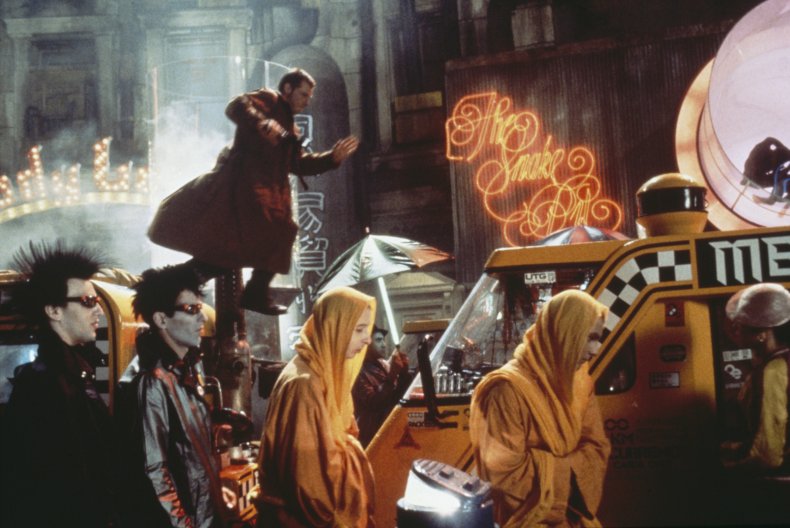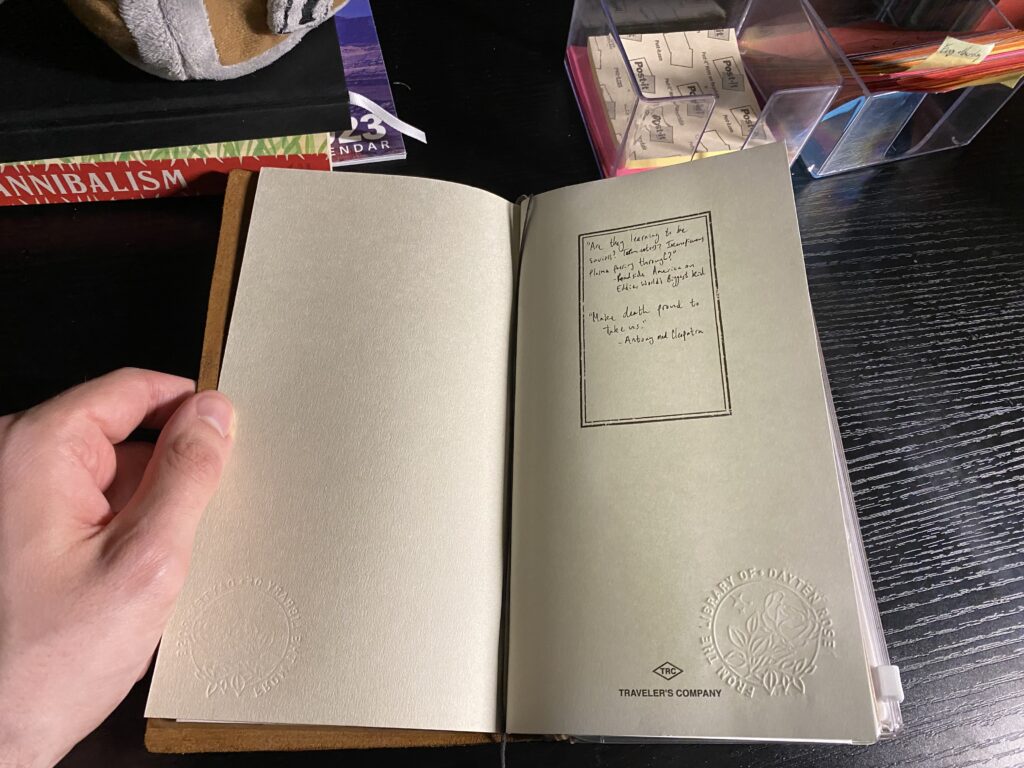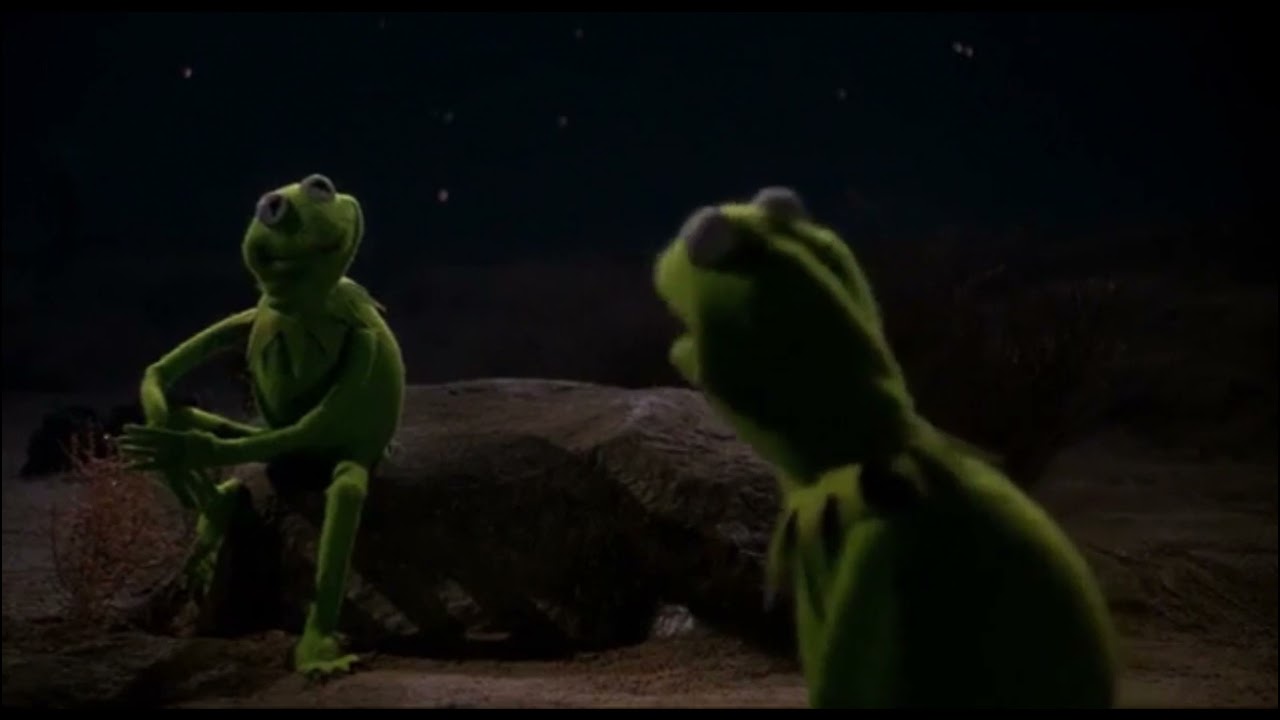Wrong notes
Spongebob Squarepants on imperfection:
All those wrong notes you played made it sound more original!
Spongebob Squarepants on imperfection:
All those wrong notes you played made it sound more original!

Unlike the movies I’ve talked about in the past, I’ve seen Blade Runner before. Actually, I studied it pretty extensively for a college essay.
But a) it’s been a while and b) this time I enjoyed what I’d consider the ideal Blade Runner viewing experience, which is to say that I had it on in the backround while attending to other things.
I watched Blade Runner Read More »
I’ve got a bunch of tabs open. Among them are three of my favorite Substacks. I’ll go through each one, break it down, and find something to steal.
My philosophy: Substack is a platform I’m really interested in, but not one I’ve rocked with extensively. I want to start before I feel ready (I think that’s a necessary skill in creative life), but I also want to make something I’m proud of. I’m a firm believer that you should work in a format you love and have opinions about. So let’s do our research before blitzing into something I end up not liking very much. (Although — I think I’ve picked out the name and topic. But that’s for a future post.)
Also, this isn’t going to be in any kind of review or critical format. I highly recommend you check out each of these.
Genre: Cultural criticism
Posts: ~1 month
Length: One idea, 1500-3000 words
internet princess is probably my favorite longform newsletter. I’m a magpie, my creative life is usually just scavenging for shiny things to steal. One thing that’s impossible to steal: someone’s original ideas developed through thoughtful observation. In other words, Rayne Fisher-Quann is extremely talented and I don’t believe that infinite bloggers on infinite typewriters could reproduce her work.
Her personal approach to writing inspires me, and that’s something I feel like I can adopt for myself. I’ve often wished I could steal her TikTok bio — “bringing blogging back.” Actually, I think it’s what inspired me to start this very blog. She writes in conversation with her readership, centers her personality in her writing, and doesn’t let herself be dominated by one Draconian rule. She wanders. She also describes the space as her “blog/newsletter/community hub” which I love, although I’m not sure I need a hub until I have spokes.
Also, I’m pretty sure she uses the default Substack layout, which thank GOD I don’t have to make things harder on myself.
Genre: Internet culture
Posts: Monday, Wednesday, and Friday (and some weekends I think?)
Length: 5-10 ideas, one ~1,000 word and the rest 100-300 words
By the way — I really hope rendering length into word count isn’t super duper reductive. The ideas are obviously the most important in all of these, but word count helps me conceptualize time.
Which, jeez louise I don’t know how you turn out this kind of word count at this kind of quality three days a week. There’s a depth of knowledge in Garbage Day that I think just comes with doing this for a long time and having a lot of familiarity.
Also, something Travis McElroy said about podcasting applies: A lasting creative project should focus on a conversation you’re already having. Ryan Broderick pulls all sorts of examples, but I get the sense they’re things he’s finding in his life already. He just then gets to write about them. Which is super cool.
I don’t think this kind of quantity fits into my life right now — the posting rate or the post length — but I love the brisk format. I also love the “stray links” at the bottom.
Genre: Creativity
Posts: Tuesday and Friday
Length: A 10 item list
Austin Kleon shapes a lot of my creative life these days. Specifically looking at his Substack though, I love a good numbered list (not a “7 wacky war crimes committed by Leos,” I mean like actually just a bulleted list of things) and I love a breezy read.
Looking at how his Substack fits into his larger writing life, I love that he repurposes the lists for his daily blog. Efficiency!
Last thing: I really admire artists who lead with their name. I worry so much that people won’t find “Dayten Rose” because it’s not spelled “Dayton.” Or they won’t know what it’s about. But it’s my blog! It’s about me!
I had a longer version of this in the chamber, but honestly I think I hit diminishing returns trying to write extensively about everything I read.
So, I’m left with these three. And they’re a really good three! I’m just not sure what they tell me. A personality-forward blog for essay-length writing on a topic I already enjoy, which includes numbered lists? A default Substack with my name attached? Probably all of these ideas will feature. Artists, like carpenters and comedians, build with material external to themselves. These three platforms inspire me, but it’s going to be impossible for me to create something that isn’t a combination of everything I’ve consumed and made a part of myself so far.
Pretty soon I’ll have something a little less abstract to show you. However I choose to describe it, I hope you’ll treat it well, because it’s me.

It’s about time I shared my secret — the reason for this whole blog thing, the whole publishing thing, the whole writing thing.
I want to go to Antarctica.
The origin of that desire is sort of secondary, though it’s not exactly a mystery. The anime A Place Further than the Universe affected me really deeply at a time when I didn’t know what to do. It’s about a quartet of teenagers going to Anarctica to recapture their youth, to find out what happened to a character’s mother. It’s an excellent show, but it leaves only an oblique forensic impact on my larger ambitions surrounding the continent.
Antarctica is also the last true frontier on Earth, if you don’t count the ocean. But I do count the ocean, and I have no desire to go down there, let alone Mars. I would maybe go to the moon, but I vibe with the moon aesthetically.
Why do I want to go to Antarctica, then? It’s not any kind of practical goal. I could see it from a plane, or a cruise, or even a guided land tour. Maybe the latter of those would satisfy me, but it’s never how I imagined things going. My plan, if I have a plan, has to do with the Antarctic Artists & Writers Program — even though, my approach is generally more journalistic than a lot of artists you find in this program. Mary Roach is a major inspiration, and she went to Antarctica, but she’s a science writer and my interest in physical science is about as great as my knowledge of what a cell is. That is, shoddy.
So I’ve made up some kind of end goal, and I have a very specific idea of how I want to get there. (Woah, déjà vu.) I know roughly when I started wanting it, what corresponds to my wanting to go, but it’s not really a reason.
The reason is that I decided it. I made a decision that I would try. I pick up and drop a lot of things, but Antarctica has never been one of them. It stuck.
Sometimes you just have to do something difficult, you know? I suffer as much as anyone else from malaise, from frustration, from melancholy. But on the whole, life is pretty easy these days (in the parts of the world I interact with regularly). We live in a golden age of fun because most survivalistic concerns have been conquered. We’re afforded the chance to attend to more complex things.
That is: To say, “I wrote several works of nonfiction of which I am proud — I contributed to the great discussions of our time, I elevated public understanding on some range of topics, digital and analog minds replicated my name and voice across space” — these are complex. Too complex to grapple with as concepts of success.
To say, “I wrote myself to Antarctica.” That is a direction and a goal. And it isn’t just a goal in the sense of objective or target. It’s Ithaka.
Keep Ithaka always in your mind.Arriving there is what you’re destined for.But don’t hurry the journey at all.Better if it lasts for years,so you’re old by the time you reach the island,wealthy with all you’ve gained on the way,not expecting Ithaka to make you rich.
Why I want to go to Antarctica Read More »

C. Thi Nguyen on what he calls “stupid games”:
Stupid games have the following characteristics: first, they are only fun if you try to win; and second, the most fun part is when you fail.
His examples are Twister, Telephone, Bag on the Head (?), and “most drinking games.”
I love the idea of stupid games just in general, and specifically as they relate to the argument C. Thi Nguyen makes in Games: Agency as Art: that games are an art form in the medium of doing, voluntary struggle in pursuit of an otherwise unnecessary goal.
Am I only now realizing that, under this argument, Edward Fortyhands is a work of art? I counter with — why wouldn’t it be? William McGonagall “gained notoriety as an extremely bad poet” according to Wikipedia. Are his poems not art, just because they’re bad?
His bio continues, “who exhibited no recognition of, or concern for, his peers’ opinions of his work.” Is that not the truest, most artistic spirit one can have in approaching their own work?
This revelation is actually, physically affecting me. I don’t know what to do with all of this energy. Let my legacy be Mona Lisa Fortyhands. Let it be Sailing to Disaster.
The slogan of this series: “Action” is an emotion and a kind of storytelling that’s worthy of pursuit.
And because the culmination of that argument comes with action movies, and the fight scene is a core building block of the action movie, I’ll start with the most circuitous sticky note and talk about guns in games.
I am personally very afraid of guns. I don’t like them. I’ve grown up in a time when it makes a lot of sense to not like guns. Nevertheless, I can recognize a huge number of firearms. Not just by name, but by sight.
The gun is ubiquitous across video game genres — most ubiquitous in the aptly named “shooter” genre. A wide majority of best-selling video games not produced by a company called “Nintendo” feature guns. This actually weakens the argument considerably because, wow, there are truly so many best-selling Nintendo games. But among people who consider themselves “serious gamers,” people who have naturalized into the hobby, I think there’s a sense that guns are core.
(Not to dismiss Nintendo fans as “fake” or anything. Animal Crossing players will save the world.)
One way to quantify this: Steam, a platform where Nintendo doesn’t trade and where users have invested in gaming PCs basically as a prerequisite for entry. SteamDB’s “currently global best selling list” looks as follows.

Real guns, fake guns, near-futuristic guns, far-futuristic guns, old timey guns, guns that shoot lasers, guns that shoot bullets, sword guns, ship guns, guns with plenty of bullets, guns with preciously few bullets. Basically any type of gun, and every dynamic of interacting with guns, is represented on this list. And this is just the most recent bestsellers. Two of the non-gun sellers are gaming hardware.
To get out ahead of this now, I think any effect video games might have on US gun culture is scant and oblique. I do not think video games make people more or less violent. The first commercial video game console was the Magnavox Odyssey, released in 1972. The only peripheral made for the Magnavox Odyssey, and the first video game peripheral ever made, was a light gun for the game Shooting Gallery, in which player shot at dots of light on the screen. Clearly the appeal of guns to players reaches far deeper than Doom.
Although, the video game industry has been insidiously embroiled with the military-industrial complex since its inception. The creator of the Magnavox Odyssey, Ralph H. Baer, was a military contractor. He worked on the console as a side project to his engineering job. The first online games were played on military servers.
Years and years of contact have handed the military greater and greater control over how it’s presented in video games. Journalist Edwin Evans-Thirlwell described the state of shooters in 2007, after the industry got tired of the WWII fan fiction originating from Saving Private Ryan and Medal of Honor.
The result, Call of Duty 4: Modern Warfare, unlocked a brand-new vocabulary for the first-person shooter. It traded the mud and everyman heroics of WW2 experiences for a slick, cheerfully amoral celebration of western military hardware and urban combat tactics—arming the player with laser sights, ghillie suits, Stinger launchers and drones. It also courted topicality where games like Medal of Honor had tried to distance themselves from the headlines—one level sees you living out the final moments of a country’s deposed president, while another puts you at the controls of an AC-130 gunship, in scenes familiar from news footage of the Iraq War.
His whole history of the FPS is such a great read on the subject.
We’re getting to the end of what I have to say about guns in games, because I think the key is really in Shooting Gallery. And it’s in the slew of games with guns that aren’t firearms. The portal guns, gravity guns, paint guns, grapple guns. Without introducing some kind of magical ability into the mix, guns are convenient in games because you can hand one to the character and say “this affects the thing you’re looking at.” It’s a way of manipulating something in the middle of your screen at range.
So that’s my answer to the guns in games question, at least how I think of it now. Guns in games are prevalent because:
That third one is sort of a dark horse, right? Well, I’ll get to clarify it in the next entry into this series. Or I’ll explore it. Or I’ll think about it really hard and not get anywhere. Suspense!
Action: Guns in games Read More »
Cory Doctorow on “enshittification“:
Here is how platforms die: first, they are good to their users; then they abuse their users to make things better for their business customers; finally, they abuse those business customers to claw back all the value for themselves. Then, they die.

Today I replaced not one, but two inserts into my Traveler’s Notebook. Which — very soon I might do a tour, because it is my favorite thing that I own.
I like to use the first page for quotes, but I try not to make them famous or meaningful ones. I prefer to write whatever’s going on in my language center at the moment and let the meaning emerge as the notebook gets filled.
Obviously the Shakespeare quote instantly betrays that preference, but it’s the one I kept thinking of:
Make death proud to take us.
From Antony and Cleopatra.
So to make up for it, the first quote comes from a Roadside America entry on Eddie, World’s Biggest Kid, in reference to the children that scurry around his entrails:
Are they learning to be saviors? Tormentors? Inconspicuous plasma passing through?
The whole article is really a treat.
EN: I had a really great weekend post-publishing of my piece in Tedium (linking once more for posterity), but I’m still learning to manage this writing, that writing, and the writing I make for my day job. This week I hope to return to some longer form idea mining. Maybe return to cell phone novels? Although I have some pretty long-overdue thoughts about pandemic media, since I’ve been watching a lot of Jenny Nicholson and made it through her catalog to the lockdown years. February may be the month of the Substack, so I’m looking forward to many exciting times ahead.
Traveler’s Notebook, page 1 Read More »
This one I’m actually pretty close to the curve on! It only came out in December of last year, and while it’s sort of already run its course, I’m sure there’s still plenty of people working their with through it. I’ll talk about what I like so far — I just finished the first chapter — without mentioning specific scenes. Spoilers, though (hehehe…).
I’m having an extremely good time, but I also realized it might take a while to finish. I’ll try and update when I’m done, but I wanted to share my early thoughts!
I started playing Pentiment Read More »

My scattered thoughts about Muppets:
It’s late so I’m writing about the Muppets Read More »